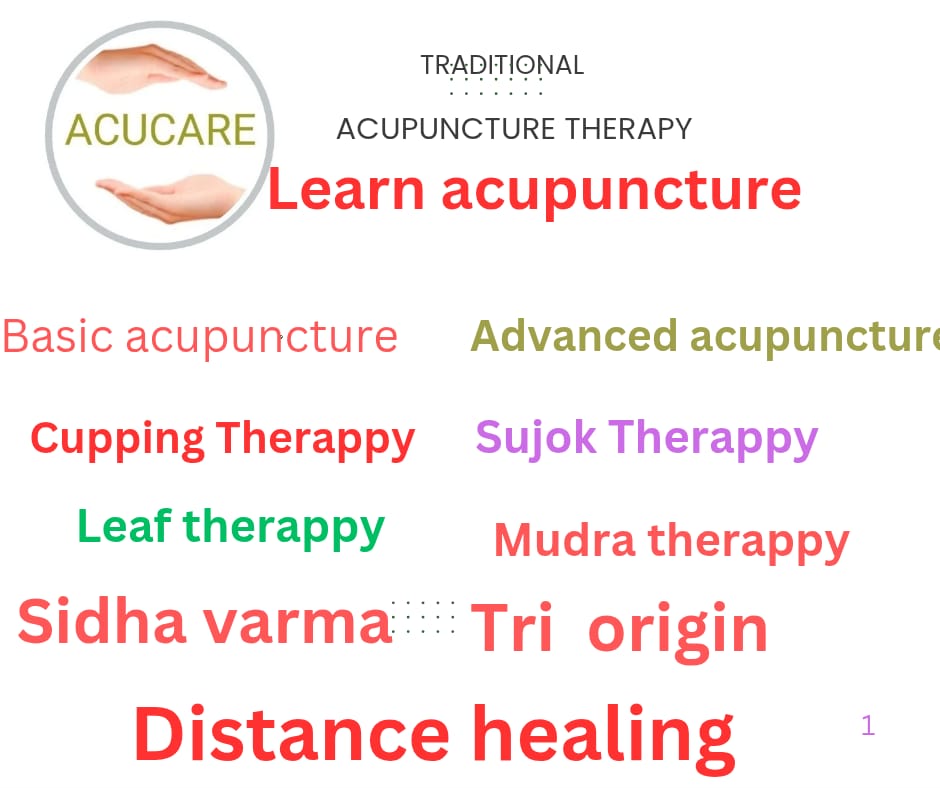Acucare Acupuncture
Kochi - Ernakulam
Products & Service Areas:
Acucare Acupuncture, Kochi, Ernakulam, Reviews, Contact number, Phone number, Address, Map, Acupuncture Treatment Center in Kochi, Ernakulam, Ratings, MORE..
Since : 2000
Kochi - Ernakulam
Products & Service Areas:
Acucare Acupuncture, Kochi, Ernakulam, Reviews, Contact number, Phone number, Address, Map, Acupuncture Treatment Center in Kochi, Ernakulam, Ratings, MORE..
Since : 2000
Siddha Varma Therapy is an ancient Indian healing system that combines the knowledge of Siddha medicine with the powerful practice of Varma (vital points) therapy. Originating in Tamil Nadu, this therapy works on the body’s vital energy points, or "Varma points," to heal ailments, improve energy flow, and promote holistic well-being. These points are critical junctures where physical, mental, and spiritual energies converge, and proper manipulation can result in significant health benefits.
In Ernakulam, Siddha Varma Therapy Centres offer this traditional healing practice to those looking for natural and holistic approaches to well-being. These centres provide specialized treatments to address various health conditions, ranging from chronic pain to stress management, in a therapeutic environment that respects ancient traditions.
Physiotherapy, also known as physical therapy, is a healthcare profession that helps individuals recover from injuries, surgeries, and medical conditions through physical exercises, manual therapy, and other rehabilitative techniques. The primary goal of physiotherapy is to restore movement and function, reduce pain, and prevent future injuries. This holistic approach can be applied to a wide range of conditions, including cardiac, post-surgical, musculoskeletal, and neurological issues such as strokes.
In this detailed guide, we will explore various types of physiotherapy rehabilitation programs, including Cardiac Rehabilitation Centers, Post-Surgery Rehabilitation, Musculoskeletal Rehabilitation, and Stroke Rehabilitation. Each rehabilitation program is designed to address specific health challenges and needs, providing patients with tailored care and support.
Cardiac rehabilitation is a specialized form of
physiotherapy aimed at helping individuals recover from heart-related issues
such as heart attacks, heart surgeries, and other cardiovascular conditions.
The program focuses on improving cardiovascular health, strength, and overall
well-being through a combination of exercises, education, and lifestyle
changes.
Key Components of Cardiac Rehabilitation:
Benefits of Cardiac Rehabilitation:
Stroke Rehabilitation
Stroke rehabilitation is a critical part of recovery
for individuals who have experienced a stroke. Physiotherapy plays a vital role
in helping stroke survivors regain physical function, improve mobility, and
enhance their quality of life. The rehabilitation process focuses on restoring
independence and maximizing the patient's ability to perform daily activities.
Key Components of Stroke Rehabilitation:
Post-surgery rehabilitation is a vital part of the
recovery process after any major surgical procedure. Physiotherapy can help
patients regain mobility, reduce pain, and rebuild strength. It is commonly
recommended for patients recovering from orthopedic surgeries (such as knee or
hip replacements), abdominal surgeries, and even cardiac surgeries.
Key Components of Post-Surgery
Rehabilitation:
Musculoskeletal Rehabilitation
Musculoskeletal rehabilitation focuses on treating
injuries and disorders affecting the muscles, bones, joints, and ligaments. It
is often recommended for conditions like arthritis, fractures, sports injuries,
and chronic pain conditions such as lower back pain or neck pain. Physiotherapy
can also address workplace injuries and repetitive strain injuries, helping
patients recover and return to their daily activities.
Key Components of Musculoskeletal
Rehabilitation:
1. What is the role of physiotherapy in
cardiac rehabilitation?
Answer: Physiotherapy plays a critical role in cardiac
rehabilitation by designing safe and effective exercise programs that improve
cardiovascular health. It helps strengthen the heart, improve stamina, and
reduce the risk of future heart problems. A physiotherapist also provides
education on managing risk factors such as diet, exercise, and stress.
2. How soon should I start physiotherapy
after surgery?
Answer: The timing of physiotherapy after surgery
depends on the type of surgery and the patient’s overall condition. In most
cases, rehabilitation can start as early as a few days after surgery, once the
patient is stable. Your doctor or surgeon will recommend the best time to begin
physiotherapy to ensure a smooth recovery.
3. What types of injuries can
musculoskeletal rehabilitation treat?
Answer: Musculoskeletal rehabilitation can treat a
wide range of conditions, including fractures, sprains, strains, dislocations,
arthritis, sports injuries, repetitive strain injuries, and chronic pain
conditions like back pain and neck pain. Physiotherapists use a combination of
manual therapy, exercises, and education to address these issues.
4. How long does stroke rehabilitation
take?
Answer: Stroke rehabilitation varies depending on the
severity of the stroke and the individual's recovery progress. While some
patients may regain significant function within a few months, others may
require ongoing therapy for several years. Early intervention and consistent
physiotherapy can greatly improve the chances of recovery.
5. Can physiotherapy help prevent future
injuries?
Answer: Yes, physiotherapy can help prevent future
injuries by improving strength, flexibility, and balance. Physiotherapists also
educate patients on proper body mechanics, posture, and ergonomic techniques,
reducing the likelihood of re-injury or developing new injuries.

Ernakulam, Kochi
Latest Customer Reviews
"Good service.. and friendy approach"